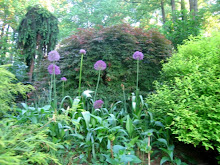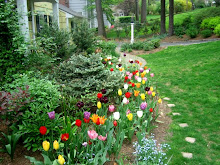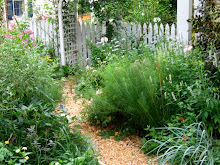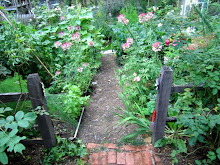 It was a wonderful day in the garden. The weather was warmish in the sun and there was very little wind. My husband and I worked today on the path in the Egg Garden that leads to the Cutting Garden. First, we added more pebbles--ten fifty pound bags or river stones--which is an annual necessity to maintain a good looking pebble path. Then, we replaced the temporary groundhog deterrent I had put down last year at the gate.
It was a wonderful day in the garden. The weather was warmish in the sun and there was very little wind. My husband and I worked today on the path in the Egg Garden that leads to the Cutting Garden. First, we added more pebbles--ten fifty pound bags or river stones--which is an annual necessity to maintain a good looking pebble path. Then, we replaced the temporary groundhog deterrent I had put down last year at the gate. In the Cutting Garden, I grow some of the groundhog's favorite foods: Queen Anne's lace, purple cone flower, and phlox. Knowing this, when I created the Cutting Garden, I dug around the border of the fence about two feet deep to install a chicken wire barrier which the groundhog couldn't get through. You can see some of this chicken wire sticking up out of the earth in the picture above.
In the Cutting Garden, I grow some of the groundhog's favorite foods: Queen Anne's lace, purple cone flower, and phlox. Knowing this, when I created the Cutting Garden, I dug around the border of the fence about two feet deep to install a chicken wire barrier which the groundhog couldn't get through. You can see some of this chicken wire sticking up out of the earth in the picture above.However, one spot was left without the barrier: the area where the gate goes into the garden. It took a few years, but the groundhog, who lives next door, discovered last year that he could dig under the gate. Looking for some immediate protection, I simply pegged a piece of chicken wire on the ground under the gate extending one foot on each side. I suppose he found enough food elsewhere that he didn't take the effort to dig underneath this barrier, but it had two problems: it was not attractive and it easily caught on the gate or your foot as you passed through.
 Our project today was to replace the temporary chicken wire with three rows of six by six inch terracotta blocks that we were using for stepping stones in other places in the garden. While digging the space for the new barrier, I discovered more terracotta blocks and chicken wire that I must have buried in an earlier attempt. We placed the new blocks level with the fence (almost touching) over all the existing material for extra protection.
Our project today was to replace the temporary chicken wire with three rows of six by six inch terracotta blocks that we were using for stepping stones in other places in the garden. While digging the space for the new barrier, I discovered more terracotta blocks and chicken wire that I must have buried in an earlier attempt. We placed the new blocks level with the fence (almost touching) over all the existing material for extra protection.I don't know why it took me so long to do this. Everything looks a lot neater now and I will no longer have to worry about tripping as I leave and enter the garden.
~
For a picture of the groundhog barrier around my vegetables, click here:
http://heirloomgardener.blogspot.com/2007/12/raised-vegetable-beds.html
~
For a prior post on the path to the Cutting Garden, click here:
http://heirloomgardener.blogspot.com/2008/01/egg-garden-path-makeover-replacing.html
~
For a prior post on keeping deer out of the backyard, click here:
http://heirloomgardener.blogspot.com/2007/12/keeping-deer-out-of-backyard-deer-fence.html























5 comments:
It all looks really good! Don't you just hate battling ground hogs! I lost ALL my sweet potatoes and beans to a ground hog last year (he ate all the leaves).
You have reminded me that I need to come up with some new strategies to keep him out this year.
Marc,
Thanks for the compliment. If you have any specific groundhog control suggestions, let me know!
Heirloom Gardener
Marc,
I just checked out your blog and saw your groundhog trials--you have it much worse than I do. I'm adding a post about your blog. Thanks for the tips.
Heirloom Gardener
Chicken wires are much more effective when attached to welded wire panels for structural support. You can always purchase them at a nearby local farm supply store. Anyway, here’s what to do when building a chicken wire fence. First, pound T-posts into the ground every 4 ft. Then, lean welded wire panels against it. Cut bendable wires to serve as a panel. Then, add a second level of panels above it. Finally, stretch chicken wire around the entire enclosure. Hope this works for you!
Cecilia Green
All the posts on one side and your post on one side, even after that, your post will look very lot of comment, see it all around, but it is nice to see your comment is very differents
CAll Girls Huda Metro
Call Girls DLF Phase 1
Gurugram Call Girls Photos
Call Girls Suraj Kund
Escorts Service Phase 4
Busty Escorts Ardee City
Call Girls Noida
Call Girls Neemrana
Post a Comment